HUMMER H3 2010 Owners Manual
Manufacturer: HUMMER, Model Year: 2010, Model line: H3, Model: HUMMER H3 2010Pages: 410, PDF Size: 2.24 MB
Page 101 of 410
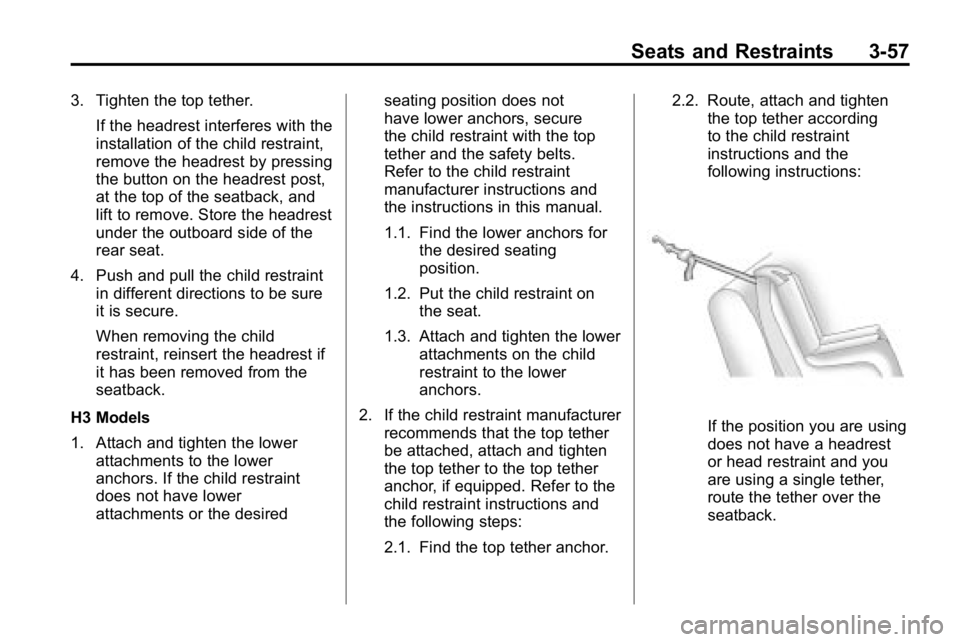
Seats and Restraints 3-57
3. Tighten the top tether.If the headrest interferes with the
installation of the child restraint,
remove the headrest by pressing
the button on the headrest post,
at the top of the seatback, and
lift to remove. Store the headrest
under the outboard side of the
rear seat.
4. Push and pull the child restraint in different directions to be sure
it is secure.
When removing the child
restraint, reinsert the headrest if
it has been removed from the
seatback.
H3 Models
1. Attach and tighten the lower attachments to the lower
anchors. If the child restraint
does not have lower
attachments or the desired seating position does not
have lower anchors, secure
the child restraint with the top
tether and the safety belts.
Refer to the child restraint
manufacturer instructions and
the instructions in this manual.
1.1. Find the lower anchors for
the desired seating
position.
1.2. Put the child restraint on the seat.
1.3. Attach and tighten the lower attachments on the child
restraint to the lower
anchors.
2. If the child restraint manufacturer recommends that the top tether
be attached, attach and tighten
the top tether to the top tether
anchor, if equipped. Refer to the
child restraint instructions and
the following steps:
2.1. Find the top tether anchor. 2.2. Route, attach and tighten
the top tether according
to the child restraint
instructions and the
following instructions:
If the position you are using
does not have a headrest
or head restraint and you
are using a single tether,
route the tether over the
seatback.
Page 102 of 410
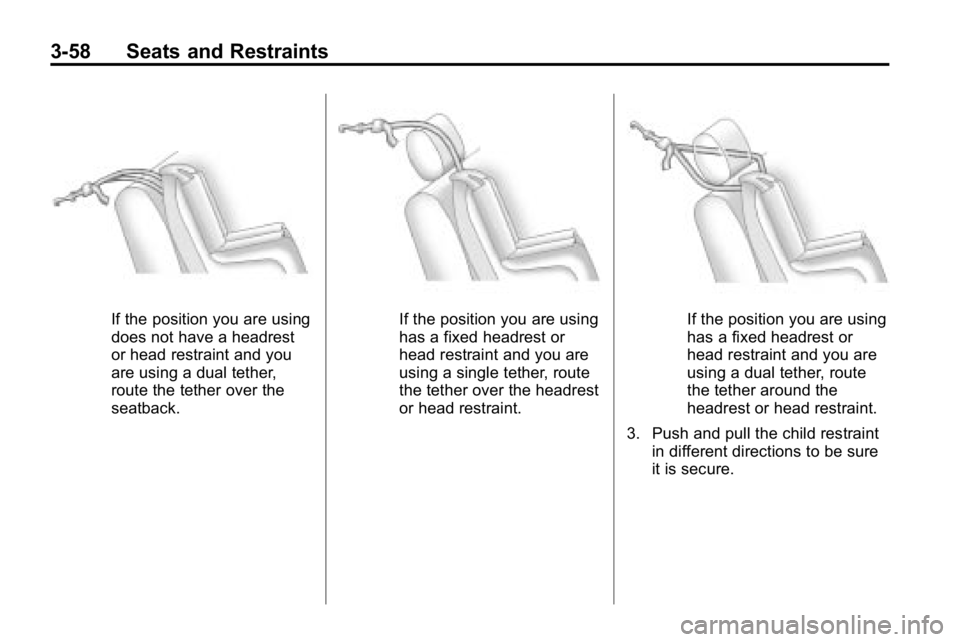
3-58 Seats and Restraints
If the position you are using
does not have a headrest
or head restraint and you
are using a dual tether,
route the tether over the
seatback.If the position you are using
has a fixed headrest or
head restraint and you are
using a single tether, route
the tether over the headrest
or head restraint.If the position you are using
has a fixed headrest or
head restraint and you are
using a dual tether, route
the tether around the
headrest or head restraint.
3. Push and pull the child restraint in different directions to be sure
it is secure.
Page 103 of 410
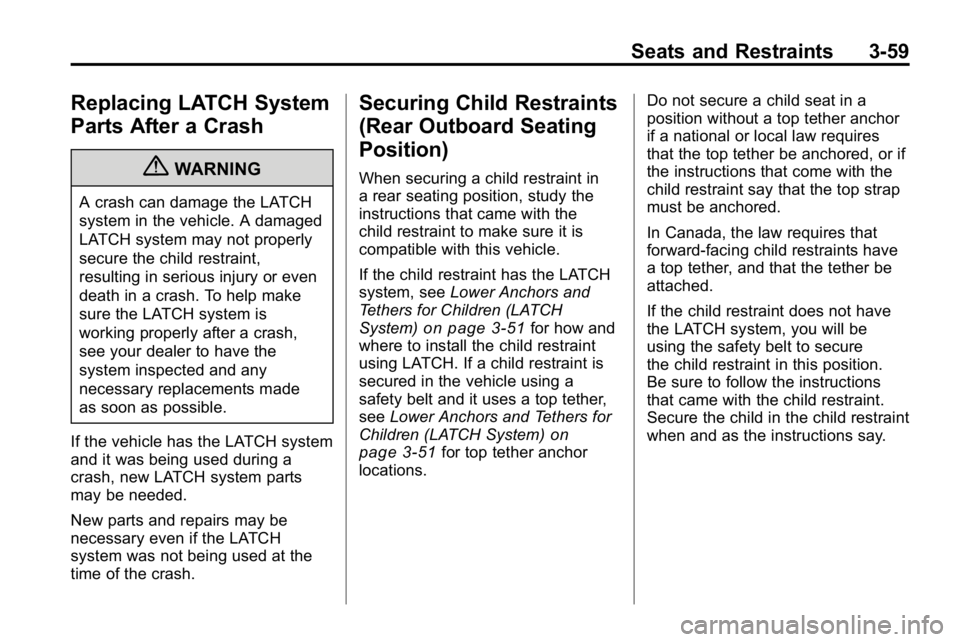
Seats and Restraints 3-59
Replacing LATCH System
Parts After a Crash
{WARNING
A crash can damage the LATCH
system in the vehicle. A damaged
LATCH system may not properly
secure the child restraint,
resulting in serious injury or even
death in a crash. To help make
sure the LATCH system is
working properly after a crash,
see your dealer to have the
system inspected and any
necessary replacements made
as soon as possible.
If the vehicle has the LATCH system
and it was being used during a
crash, new LATCH system parts
may be needed.
New parts and repairs may be
necessary even if the LATCH
system was not being used at the
time of the crash.
Securing Child Restraints
(Rear Outboard Seating
Position)
When securing a child restraint in
a rear seating position, study the
instructions that came with the
child restraint to make sure it is
compatible with this vehicle.
If the child restraint has the LATCH
system, see Lower Anchors and
Tethers for Children (LATCH
System)
on page 3‑51for how and
where to install the child restraint
using LATCH. If a child restraint is
secured in the vehicle using a
safety belt and it uses a top tether,
see Lower Anchors and Tethers for
Children (LATCH System)
on
page 3‑51for top tether anchor
locations. Do not secure a child seat in a
position without a top tether anchor
if a national or local law requires
that the top tether be anchored, or if
the instructions that come with the
child restraint say that the top strap
must be anchored.
In Canada, the law requires that
forward-facing child restraints have
a top tether, and that the tether be
attached.
If the child restraint does not have
the LATCH system, you will be
using the safety belt to secure
the child restraint in this position.
Be sure to follow the instructions
that came with the child restraint.
Secure the child in the child restraint
when and as the instructions say.
Page 104 of 410

3-60 Seats and Restraints
If more than one child restraint
needs to be installed in the rear
seat, be sure to readWhere to Put
the Restraint on page 3‑49.
1. Put the child restraint on the seat.
2. Pick up the latch plate, and run the lap and shoulder portions of
the vehicle's safety belt through
or around the restraint. The child
restraint instructions will show
you how.
3. For H3T models, tilt the latchplate to adjust the belt if needed.
4. Push the latch plate into thebuckle until it clicks.
Position the release button on
the buckle so that the safety belt
could be quickly unbuckled if
necessary.5. For H3 models, pull the rest ofthe shoulder belt all the way out
of the retractor to set the lock.
Page 105 of 410

Seats and Restraints 3-61
6. To tighten the belt, push downon the child restraint, pull the
shoulder portion of the belt to
tighten the lap portion of the belt
and feed the shoulder belt back
into the retractor. When installing
a forward-facing child restraint,
it may be helpful to use your
knee to push down on the child
restraint as you tighten the belt. 7. If the child restraint has a top
tether, follow the child restraint
manufacturer's instructions
regarding the use of the top
tether. See Lower Anchors and
Tethers for Children (LATCH
System)
on page 3‑51for more
information.
For H3T models, if the headrest
interferes with the installation of
the child restraint, remove the
headrest by pressing the button
on the headrest post, at the
top of the seatback, and lift to
remove. Store the headrest
under the outboard side of the
rear seat.
8. Push and pull the child restraint in different directions to be sure
it is secure.
To remove the child restraint,
unbuckle the vehicle safety belt and
let it return to the stowed position.
If the top tether is attached to a top
tether anchor, disconnect it. If the
headrest has been removed,
reinsert it onto the seatback.
Securing Child Restraints
(Rear Center Seating
Position)
Many child restraints are too wide to
be correctly secured in the center
rear seat, although some of them
will fit there. If the center seat
position is too narrow for the child
restraint, secure it in a rear outside
seat position.
If a child restraint is secured in the
center seat position, follow the
instructions in Securing Child
Restraints (Rear Outboard Seating
Position)
on page 3‑59or Securing
Child Restraints (Rear Center
Seating Position)
on page 3‑61or
Securing Child Restraints (Right
Front Seat Position) on page 3‑62.
Page 106 of 410
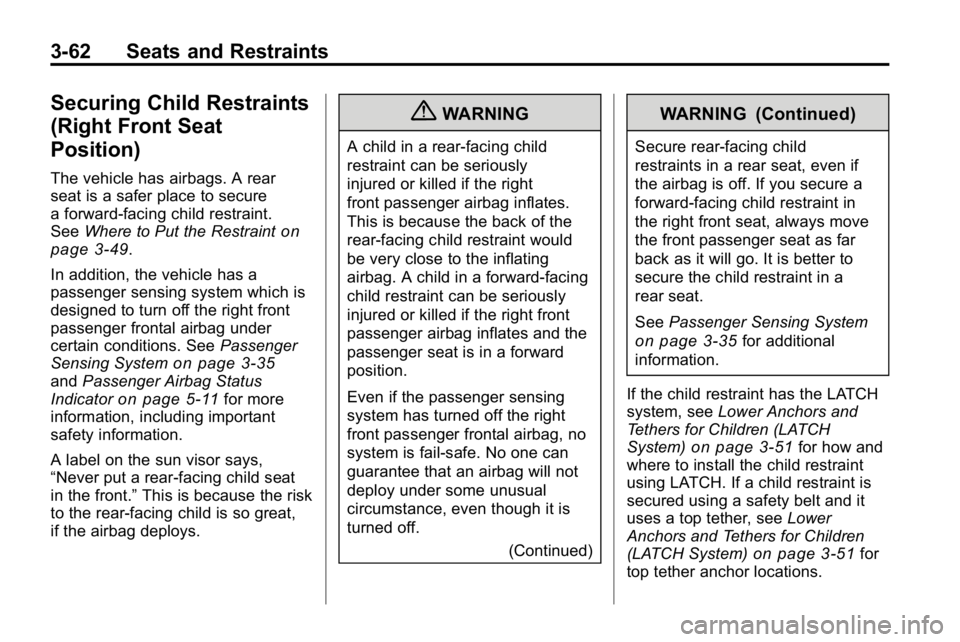
3-62 Seats and Restraints
Securing Child Restraints
(Right Front Seat
Position)
The vehicle has airbags. A rear
seat is a safer place to secure
a forward-facing child restraint.
SeeWhere to Put the Restraint
on
page 3‑49.
In addition, the vehicle has a
passenger sensing system which is
designed to turn off the right front
passenger frontal airbag under
certain conditions. See Passenger
Sensing System
on page 3‑35and Passenger Airbag Status
Indicatoron page 5‑11for more
information, including important
safety information.
A label on the sun visor says,
“Never put a rear-facing child seat
in the front.” This is because the risk
to the rear-facing child is so great,
if the airbag deploys.
{WARNING
A child in a rear-facing child
restraint can be seriously
injured or killed if the right
front passenger airbag inflates.
This is because the back of the
rear-facing child restraint would
be very close to the inflating
airbag. A child in a forward-facing
child restraint can be seriously
injured or killed if the right front
passenger airbag inflates and the
passenger seat is in a forward
position.
Even if the passenger sensing
system has turned off the right
front passenger frontal airbag, no
system is fail-safe. No one can
guarantee that an airbag will not
deploy under some unusual
circumstance, even though it is
turned off.
(Continued)
WARNING (Continued)
Secure rear-facing child
restraints in a rear seat, even if
the airbag is off. If you secure a
forward-facing child restraint in
the right front seat, always move
the front passenger seat as far
back as it will go. It is better to
secure the child restraint in a
rear seat.
SeePassenger Sensing System
on page 3‑35for additional
information.
If the child restraint has the LATCH
system, see Lower Anchors and
Tethers for Children (LATCH
System)
on page 3‑51for how and
where to install the child restraint
using LATCH. If a child restraint is
secured using a safety belt and it
uses a top tether, see Lower
Anchors and Tethers for Children
(LATCH System)
on page 3‑51for
top tether anchor locations.
Page 107 of 410
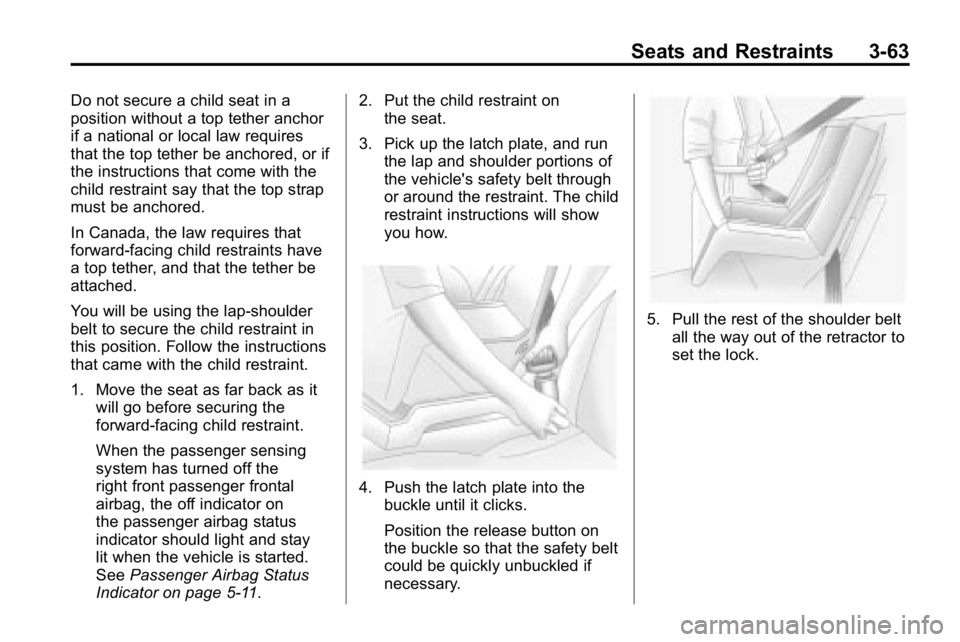
Seats and Restraints 3-63
Do not secure a child seat in a
position without a top tether anchor
if a national or local law requires
that the top tether be anchored, or if
the instructions that come with the
child restraint say that the top strap
must be anchored.
In Canada, the law requires that
forward-facing child restraints have
a top tether, and that the tether be
attached.
You will be using the lap-shoulder
belt to secure the child restraint in
this position. Follow the instructions
that came with the child restraint.
1. Move the seat as far back as itwill go before securing the
forward-facing child restraint.
When the passenger sensing
system has turned off the
right front passenger frontal
airbag, the off indicator on
the passenger airbag status
indicator should light and stay
lit when the vehicle is started.
See Passenger Airbag Status
Indicator on page 5‑11. 2. Put the child restraint on
the seat.
3. Pick up the latch plate, and run the lap and shoulder portions of
the vehicle's safety belt through
or around the restraint. The child
restraint instructions will show
you how.
4. Push the latch plate into thebuckle until it clicks.
Position the release button on
the buckle so that the safety belt
could be quickly unbuckled if
necessary.
5. Pull the rest of the shoulder beltall the way out of the retractor to
set the lock.
Page 108 of 410
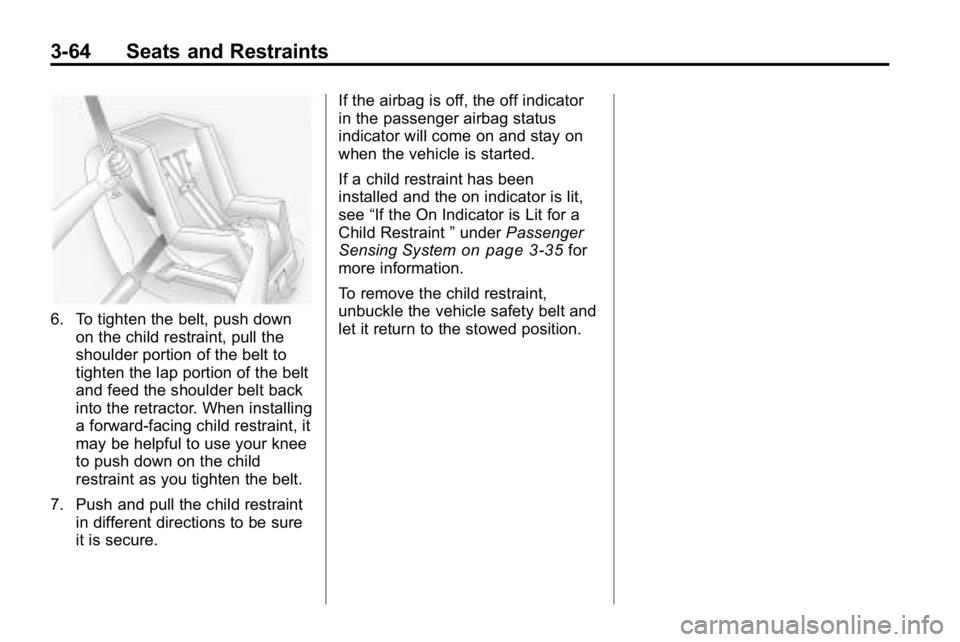
3-64 Seats and Restraints
6. To tighten the belt, push downon the child restraint, pull the
shoulder portion of the belt to
tighten the lap portion of the belt
and feed the shoulder belt back
into the retractor. When installing
a forward-facing child restraint, it
may be helpful to use your knee
to push down on the child
restraint as you tighten the belt.
7. Push and pull the child restraint in different directions to be sure
it is secure. If the airbag is off, the off indicator
in the passenger airbag status
indicator will come on and stay on
when the vehicle is started.
If a child restraint has been
installed and the on indicator is lit,
see
“If the On Indicator is Lit for a
Child Restraint ”under Passenger
Sensing System
on page 3‑35for
more information.
To remove the child restraint,
unbuckle the vehicle safety belt and
let it return to the stowed position.
Page 109 of 410
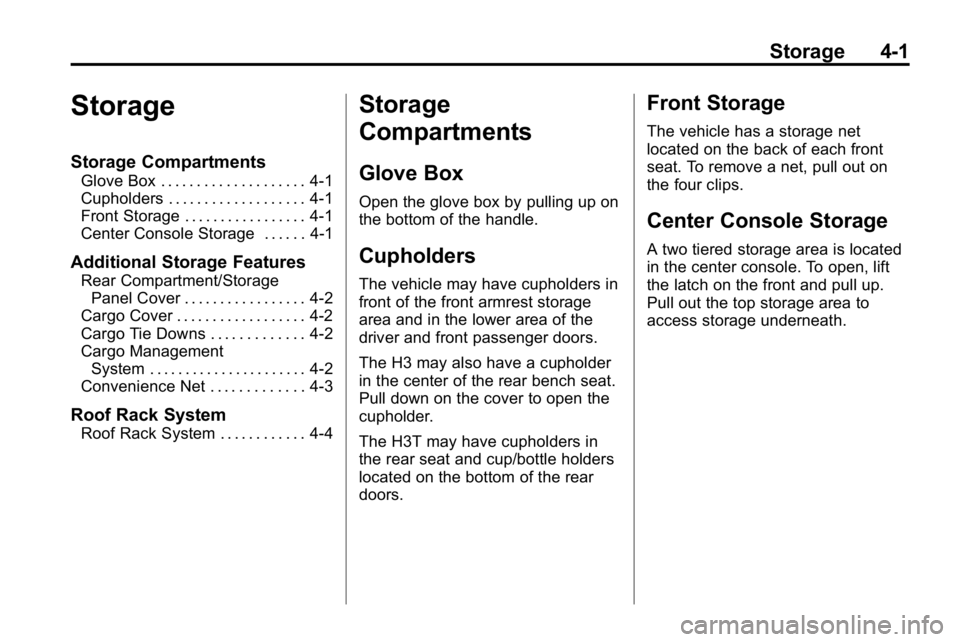
Storage 4-1
Storage
Storage Compartments
Glove Box . . . . . . . . . . . . . . . . . . . . 4-1
Cupholders . . . . . . . . . . . . . . . . . . . 4-1
Front Storage . . . . . . . . . . . . . . . . . 4-1
Center Console Storage . . . . . . 4-1
Additional Storage Features
Rear Compartment/StoragePanel Cover . . . . . . . . . . . . . . . . . 4-2
Cargo Cover . . . . . . . . . . . . . . . . . . 4-2
Cargo Tie Downs . . . . . . . . . . . . . 4-2
Cargo Management System . . . . . . . . . . . . . . . . . . . . . . 4-2
Convenience Net . . . . . . . . . . . . . 4-3
Roof Rack System
Roof Rack System . . . . . . . . . . . . 4-4
Storage
Compartments
Glove Box
Open the glove box by pulling up on
the bottom of the handle.
Cupholders
The vehicle may have cupholders in
front of the front armrest storage
area and in the lower area of the
driver and front passenger doors.
The H3 may also have a cupholder
in the center of the rear bench seat.
Pull down on the cover to open the
cupholder.
The H3T may have cupholders in
the rear seat and cup/bottle holders
located on the bottom of the rear
doors.
Front Storage
The vehicle has a storage net
located on the back of each front
seat. To remove a net, pull out on
the four clips.
Center Console Storage
A two tiered storage area is located
in the center console. To open, lift
the latch on the front and pull up.
Pull out the top storage area to
access storage underneath.
Page 110 of 410
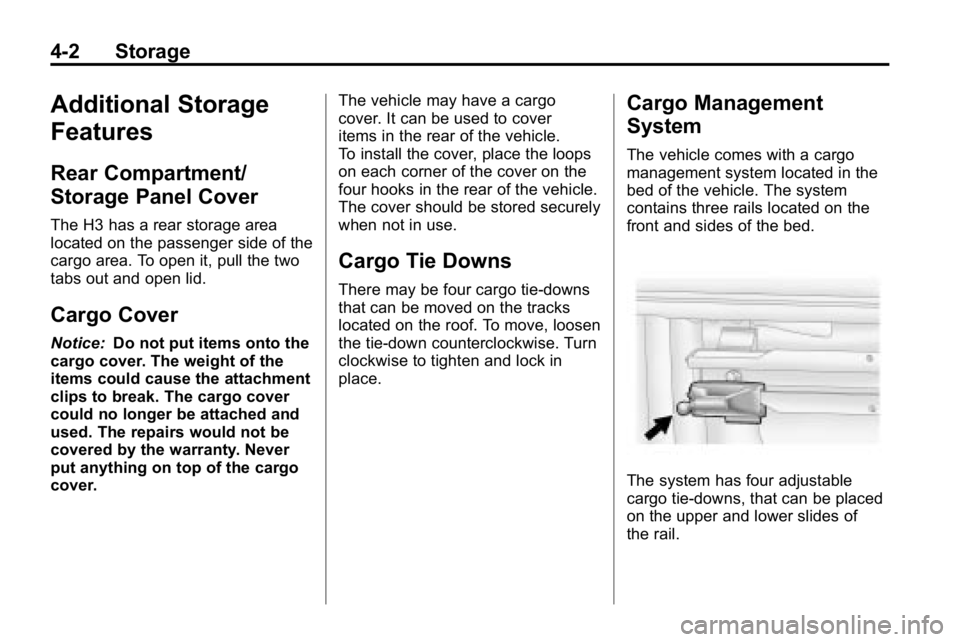
4-2 Storage
Additional Storage
Features
Rear Compartment/
Storage Panel Cover
The H3 has a rear storage area
located on the passenger side of the
cargo area. To open it, pull the two
tabs out and open lid.
Cargo Cover
Notice:Do not put items onto the
cargo cover. The weight of the
items could cause the attachment
clips to break. The cargo cover
could no longer be attached and
used. The repairs would not be
covered by the warranty. Never
put anything on top of the cargo
cover. The vehicle may have a cargo
cover. It can be used to cover
items in the rear of the vehicle.
To install the cover, place the loops
on each corner of the cover on the
four hooks in the rear of the vehicle.
The cover should be stored securely
when not in use.
Cargo Tie Downs
There may be four cargo tie-downs
that can be moved on the tracks
located on the roof. To move, loosen
the tie-down counterclockwise. Turn
clockwise to tighten and lock in
place.
Cargo Management
System
The vehicle comes with a cargo
management system located in the
bed of the vehicle. The system
contains three rails located on the
front and sides of the bed.
The system has four adjustable
cargo tie-downs, that can be placed
on the upper and lower slides of
the rail.